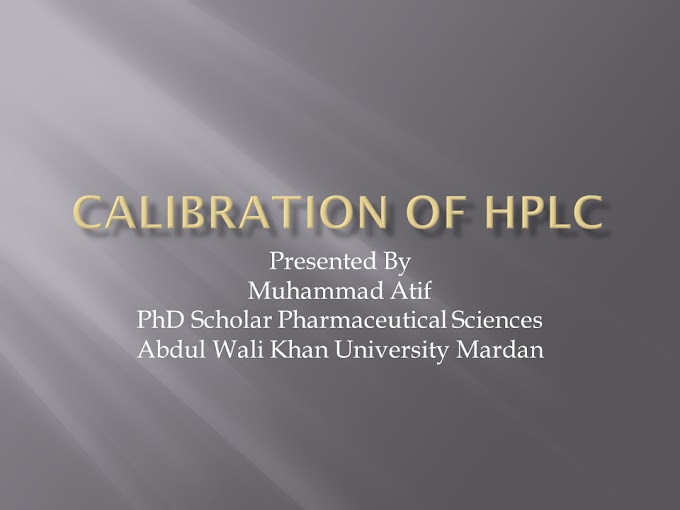Calibration of UV/Visible
Spectrophotometer
Calibration of UV/Visible
Spectrophotometer
¨ Calibration
of UV/Visible Spectrophotometer involves following parameters
¨ Absorption
Cells
¨ Control
of Absorbance
¨ Resolution
Power
¨ Limit
of Stray Light
¨ Linearity
¨ Control
of Wavelength
Procedure
¨ Properly
check the instrument connection and then switch on.
¨ When
the instrument gets on properly then start calibration step by step for
checking the above mentioned parameters one by one properly and record the
data.
Absorption Cell
¨ Properly
clean up the cell with methanol and remove any spot if present.
¨ Now
rinse the cell with distilled water and then fill with distilled water.
¨ Measure
the apparent absorbance at 240 nm for quartz cell and 650 nm for glass cell.
¨ The
apparent absorbance observed should not be more than 0.093 for 1 cm quartz cell
(UV regions) and 0.035 for 1 cm glass cell (Visible region).
¨ Now
rotate the cell in its holder at 180◦ and measure the absorbance again and
record the data.
Acceptance Criteria
¨ The
difference in absorbance after rotation should not be more than 0.005 from its
initial absorbance.
Control of Absorbance
¨ For
the Calibration of UV region absorbance prepare 60ppm solution of
Potassium dichromate solution using 0.005 M sulphuric acid as follow.
¨ Take
60 mg of potassium dichromate previously dried up to constant mass at 130◦C.
¨ Transfer
it into a 1000 ml volumetric flask and dissolve in sufficient quantity of 0.005
M sulphuric acid and then make final volume with the same solvent.
¨ Measure
the absorbance at 235 nm, 257 nm, 313 nm and 350 nm using 0.005 M
sulphuric acid as blank.
¨ For
the calibration of Visible region absorbance prepare 600ppm solution of
potassium dichromate in 0.005 M sulphuric acid.
¨ Measure
the absorbance of 600ppm solution of potassium dichromate in 0.005 M sulphuric
acid at 430 nm using 0.005 M sulphuric acid as blank.
Acceptance criteria:
|
Wavelength (nm) |
Specific absorbance |
Limit |
|
235 |
124.5 |
122.9 --- 126.2 |
|
257 |
144.5 |
142.8 --- 146.2 |
|
313 |
48.6 |
47.0 --- 50.3 |
|
350 |
107.3 |
105.6 --- 109 |
|
430 |
|
Resolution
Power
¨ To
calibrate Resolution prepare a 0.02% V/V solution of toluene in hexane.
¨ Record
the spectrum of the above said 0.02% toluene solution in the range of 250 nm
to 300 nm using hexane as blank.
Acceptance
Criteria:
¨ Ratio
of the absorbance maximum at 269 nm and minimum 265 nm should not be less than
1.5.
Limit of
Stray Light
¨ For
this parameter prepare a 1.2% w/v solution of potassium chloride in distilled
water.
¨ Record
the absorbance at 198 nm, 200nm and 202 nm using distilled water as blank.
Acceptance
Criteria:
¨ Absorbance
should not be less than 2.0
Linearity
¨ For
linearity prepare 100 ppm, 80ppm, 60ppm, 40ppm and 20 ppm solution of
previously dried potassium dichromate at 130◦c up to constant mass in 0.005 M
sulphuric acid.
¨ Measure
the absorbance at 257 nm using 0.005 M sulphuric acid as blank.
¨ Plot
a graph between absorbance vs concentration.
Acceptance
criteria:
¨ R-square
should not be less than 0.999
Control of
Wavelength
¨ Prepare
4.0% holmium oxide solution in 1.4 M perchloric acid by dissolving 1.0 g of
holmium oxide in 25 ml of 1.4 M perchloric acid.
¨ Check
the wavelength at 241.15nm, 287.15nm, 361.5nm, 486nm and 536.3 nm for the peak
detection of holmium oxide using 1.4M perchloric acid as blank.
Acceptance
Criteria:
¨ Tolerance
limit should be ±1 for 200nm to 400nm and ±3 for 400nm to 800nm.
Out of
Calibration
¨ In
case of failure of any of the parameter the instrument should be labeled as
“OUT OF CALIBRATION” and should be repaired / serviced.
¨ After repairing or servicing the instrument should be again calibrated.






2 Comments
❣👍
ReplyDelete👌👍👍👍
ReplyDelete